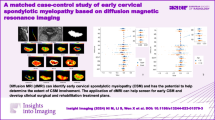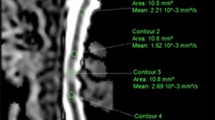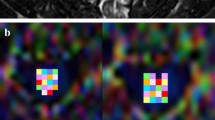Abstract
Objective
To investigate whether multi-shot diffusion-weighted imaging (ms-DWI) could be applied in diagnosis and quantitative evaluation of cervical spondylotic myelopathy (CSM).
Methods
Thirty-three normal volunteers and 78 patients with CSM were included in this study. The apparent diffusion coefficient (ADC) values were measured at C2–C7 levels on sagittal section ADC map. The intraclass correlation coefficient (ICC) and Bland and Altman plot and Spearman coefficient were used to quantify the reproducibility of test and retest and inter-rater reliability. Pearson correlations were calculated to compare lADC and rADC versus mJOA and NDI scores. Receiver operating characteristic curve and the area under the curve (AUC) were applied to evaluate the diagnostic reliability.
Results
There was no statistically significant difference between ADC values obtained from normal volunteers at C2–C7 levels (P < 0.05). The ICC and spearman coefficient of lADC and rADC indicated excellent test–retest and inter-rater reliability. The mean lADC and rADC were significantly higher from patients than that from volunteers (all P < 0.01). The lADC had moderate to good correlations with mJOA and NDI (all P < 0.0001). Moreover, rADC had good to excellent correlations with mJOA and NDI (all P < 0.0001). Comparing AUCs, rADC was significantly superior in diagnosis which participants were CSM than lADC (P = 0.0118).
Conclusion
The ms-DWI could be applied in diagnosis and quantitive assessment of CSM according to lADC and rADC. A new parameter, rADC, could be served as a diagnostic indice for CSM, which may quantitively reflect the severity of CSM.
Graphic abstract
These slides can be retrieved under Electronic Supplementary Material.







Similar content being viewed by others
References
Karadimas SK, Gatzounis G, Fehlings MG (2015) Pathobiology of cervical spondylotic myelopathy. Eur Spine J 24(2 Supplement):132–138
Levine DN (1997) Pathogenesis of cervical spondylotic myelopathy. J Neurol Neurosurg Psychiatry 62(4):334–340
Zhang YZ, Wang LF, Shen Y, Ding WY, Xu JX, He J (2010) The effects of MRI signal intensity changes and clinical manifestations on prognosis after surgical intervention for cervical spondylotic myelopathy. Orthop Surg 1(2):101–106
Singh A, Crockard HA, Platts A, Stevens J (2001) Clinical and radiological correlates of severity and surgery-related outcome in cervical spondylosis. J Neurosurg 94(2 Suppl):189
Molko N, Pappata S, Mangin JF, Poupon C, Vahedi K, Jobert A, Lebihan D, Bousser MG, Chabriat H (2001) Diffusion tensor imaging study of subcortical gray matter in cadasil. Stroke 32(9):2049–2054
Tanenbaum LN (2013) Clinical applications of diffusion imaging in the spine. Magn Reson Imaging Clin N Am 21(2):299
Schlaug G, Siewert B, Benfield A, Edelman RR, Warach S (1997) Time course of the apparent diffusion coefficient (ADC) abnormality in human stroke. Neurology 49(1):113–119
Staff TPO (2015) Correction: comparison of the Japanese Orthopaedic Association (JOA) score and modified JOA (mJOA) score for the assessment of cervical myelopathy: a multicenter observational study. PLoS ONE 10(4):e0123022
Chien A, Lai DM, Cheng CH, Wang SF, Hsu WL, Wang JL (2015) Responsiveness of the Chinese versions of the Japanese Orthopaedic Association Cervical Myelopathy Evaluation Questionnaire and Neck Disability Index in postoperative patients with cervical spondylotic myelopathy. Spine 40(17):1315–1321
Savva C, Karagiannis C, Rushton A (2013) Test-retest reliability of grip strength measurement in full elbow extension to evaluate maximum grip strength. J Hand Surg Eur 38(2):183–186
Andrade MS, Koffes FDC, Benedito-Silva AA, Silva ACD, Lira CABD (2016) Effect of fatigue caused by a simulated handball game on ball throwing velocity, shoulder muscle strength and balance ratio: a prospective study. BMC Sports Sci Med Rehabil 8(1):13
Thompson AW, Hantke N, Phatak V, Chaytor N (2010) The Personality Assessment Inventory as a tool for diagnosing psychogenic nonepileptic seizures. Epilepsia 51(1):161–164
Nouri A, Tetreault L, Dalzell K, Zamorano JJ, Fehlings MG (2017) The relationship between preoperative clinical presentation and quantitative magnetic resonance imaging features in patients with degenerative cervical myelopathy. Neurosurgery 06(S 01):1
Lawrence BD, Shamji MF, Traynelis VC, Yoon ST, Rhee JM, Chapman JR, Brodke DS, Fehlings MG (2013) Surgical management of degenerative cervical myelopathy: a consensus statement. Spine 38(1):171–172
Baron EM, Young WF (2007) Cervical spondylotic myelopathy: a brief review of its pathophysiology, clinical course, and diagnosis. Neurosurgery 60(1):35–41
Kaiser Jay A (1998) Summary: imaging of the cervical spine. Spine 23(24):2712
Wei L, Cao P, Xu C, Liu Y, Chen H, Wang X, Tian Y, Yuan W (2019) The relationship between preoperative factors and the presence of intramedullary increased signal intensity on T2-weighted magnetic resonance imaging in patients with cervical spondylotic myelopathy. Clin Neurol Neurosurg 178:1–6
Fengning L, Zhi C, Fan Z, Hongxing S, Tiesheng H (2011) A meta-analysis showing that high signal intensity on T2-weighted MRI is associated with poor prognosis for patients with cervical spondylotic myelopathy. J Clin Neurosci Off J Neurosurg Soc Australas 18(12):1592–1595
Chen CJ, Lyu RK, Lee ST, Wong YC, Wang LJ (2001) Intramedullary high signal intensity on T2-weighted MR images in cervical spondylotic myelopathy: prediction of prognosis with type of intensity. Radiology 221(3):789–794
Le BD (1991) Molecular diffusion nuclear magnetic resonance imaging. Magn Reson Q 7(1):1–30
Masaaki H, Toshiyuki O, Shigeki A, Hiroshi K, Tsutomu A (2010) Line scan diffusion tensor MRI at low magnetic field strength: feasibility study of cervical spondylotic myelopathy in an early clinical stage. J Magn Reson Imaging JMRI 23(2):183–188
Mamata H, Jolesz FA, Maier SE (2005) Apparent diffusion coefficient and fractional anisotropy in spinal cord: age and cervical spondylosis-related changes. J Magn Reson Imaging 22(1):38–43
Zecca C, Wetzel S, Tschuor S, Staedler C, Santini F, Nadarajah N, Bassetti CL, Gobbi C (2012) Diffusion-weighted imaging in acute demyelinating myelopathy. Neuroradiology 54(6):573–578
郑奎宏, 马林, 郭行高, 梁丽 (2006) 正常人颈髓MR扩散张量成像的初步研究. 中华放射学杂志 40(5):490–493
Roland B, Franz F (2003) Diffusion imaging of the human spinal cord and the vertebral column. Top Magn Reson Imaging 14(6):461–476
Funding
This study was supported by grants from the National Natural Science Foundation of China (81702141), National Natural Science Foundation of China (CN) (No. 81802218), and National Natural Science Foundation of China (CN) (81871828).
Author information
Authors and Affiliations
Corresponding author
Ethics declarations
Conflict of interest
The authors declare that they have no conflict of interest.
Additional information
Publisher's Note
Springer Nature remains neutral with regard to jurisdictional claims in published maps and institutional affiliations.
Electronic supplementary material
Below is the link to the electronic supplementary material.
Rights and permissions
About this article
Cite this article
Xu, X., Zhang, B., Sun, K. et al. Reliability and validity of multi-shot DWI in diagnosis of cervical spondylotic myelopathy: a study based on 3-T MRI. Eur Spine J 29, 1219–1226 (2020). https://doi.org/10.1007/s00586-020-06381-z
Received:
Revised:
Accepted:
Published:
Issue Date:
DOI: https://doi.org/10.1007/s00586-020-06381-z




